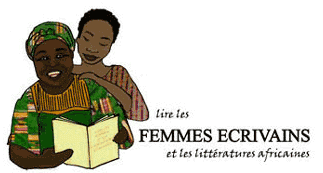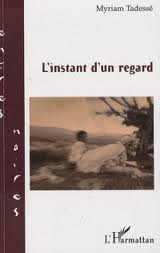|
NOT TO BE MISSED "L'instant d'un regard" [A Moment in Time], an autobiographical novel by Myriam TADESSÉ Paris: L'Harmattan, 2009. (102p.). ISBN: 978-2-296-08445-2.
|

Ce compte rendu en français |
Concise, dense, very well written and highly evocative, this autobiographical narrative proposes a compelling depiction of an Ethiopian family: one that spans the twentieth century. Well articulated short chapters lay bare the ordeal of three generations of individuals who had to adapt, as best they could, to the tumultuous history of their country. But the political impositions of successive governments on the family account for only part of their strain as people's temperaments and diverging expectations are also taking their toll. The story begins in 1991, when the matriarch has just died. An old photograph showing her sitting on the grass with her younger sister, on the outskirts of Addis Ababa, captures the imagination of her granddaughter Myriam and releases a flow of thoughts and forgotten memories.
 The picture is dated May 1956 and Myriam wonders what the two languorous ladies, immortalised during a relaxing picnic in the country, had in mind. Was it plain bliss, or more likely moments of serenity, already defiled by the faint hints of anxiety noticeable on their faces? Come rain or shine, new challenges had always been thrown in their path and, in their intuitive wisdom, they understood that in the morrow of peace and quiet always lay confrontation and war. Grandmother had to endure the consequence of this harsh principle from an early age.
The picture is dated May 1956 and Myriam wonders what the two languorous ladies, immortalised during a relaxing picnic in the country, had in mind. Was it plain bliss, or more likely moments of serenity, already defiled by the faint hints of anxiety noticeable on their faces? Come rain or shine, new challenges had always been thrown in their path and, in their intuitive wisdom, they understood that in the morrow of peace and quiet always lay confrontation and war. Grandmother had to endure the consequence of this harsh principle from an early age.
Married to a forbidding fellow at the age of fourteen, she had little opportunity to enjoy the pleasures of matrimony with a man who "looks as conciliatory and prepossessing as a lion to whom one tries to palm off some yoghurt" (p.31). This stern grandfather begat her five children – of whom two died in infancy – and they were still small when this stately patriarch met his maker in front of a firing squad in 1937. Before the 1936 Italian invasion, he had been, for many years, a close collaborator of Ethiopia's Regent, Ras Tafari Makonnen, later crowned Emperor Hailé Sélassié. Therefore his name was top of the list when alleged partisans, supporters of the old Regime and thousands of unsuspecting Ethiopians were summarily executed following a failed attempt on the life of the Viceroy, the fascist Marshal Rodolpho Graziani.
Is it then that Grandmother became this ageless woman of few words and firm character who smiled little? Her husband gone, she had to fight for survival in the most difficult of circumstances; and the collaboration of one of her in-laws with the Italian invaders only added insult to injury. By 1956 though, the country's integrity had been restored, the Emperor was back in charge, the Italian occupation was a thing of the past and her children made good of themselves. But as she was enjoying an afternoon in the country with her sister and family, did she think about the similarity between the destiny of her late husband and that of her son who had also been invited by the Emperor to join the country's civil service? Did she ponder the nature of the challenges of the years ahead? The invitation of the Emperor could not be declined and, like his father before him, the young man had embarked on a string of postings in various Departments where he had learned the ropes before becoming a consummate politician.
History continues to repeat itself in 1974. The enemy is not an outsider though; this time it comes from within as a military junta deposes Hailé Sélassié, arrests hundreds of people and eventually kills hundred of thousands during the years that follow. Myriam's father, like her grandfather in the previous generation, is arrested, imprisoned and while his life is spared, he was to languish in jail, vainly awaiting a trial that never occurred. When eventually he is released after eight years of confinement, he feels dead inside and unable to spring back to life. The lengthy separation from his folk also has dire consequences on family relationships. His daughter was a child of nine when he disappeared into the entrails of jail and she has become a lively eighteen year old when they are reunited. She now lives in France, has made her stage debut and is dating an older boyfriend who, she says, "combines the impudence of a Coluche and the poetic licence of a Verlaine" (p.91). That, of course, does not go down too well with her father who feels deprived of the chimerical image of his young daughter after losing everything else, bar his own life.
His reunion with his wife is no better and the unhappy relationship that dominated the couple's interactions before his imprisonment only get worse. His political downfall was not of his making, but his failed marriage was. Thus the narrator's portrayal of a man's destiny that epitomizes both the chilling delineation of History and the shortcomings of human nature. A few years after his return to Ethiopia, after studying abroad, Myriam's father had married a French beauty sojourning in Addis Ababa. But the romance was short-lived as Myriam's mother found it hard to settle in a country which resisted all her attempts to integrate. The Amharic language remained impenetrable to her, the food did not agree with her digestive system, cocky house-maids and servants were laughing behind her back and, worst of all, her husband, full of sarcasm, refused to lend her support. Instead, neglecting the advice that would have allowed her to adapt to the country, "he pushed aside her repeated complaints as one would chase off a bothering fly" (p.49).
Paradoxically, it is only the jailing of her husband that prevented Myriam's mother to file for divorce and her subsequent return to France, where Myriam's father ended up living after his release, increasing the psychological, emotional and moral distance separating the spouses. Even before his arrest, nothing except the dos and don'ts of social constraints had kept the family together. As Myriam recalls, "when daddy was coming back from work, exhausted, angry and tense, he always played first with his dog, then with me and only then, he uttered a vague hello to his wife" (p.52). Ten years later, his dog is dead, his daughter is living her own life and his wife is still engulfed in an ocean of incomprehension and solitude.
Myriam's own story is interesting because it blends somewhat contradictory worlds. Unlike her father, she feels strong ties with France where she discovered freedom and love; but unlike her mother she has fond memories of Ethiopia where she grew up under the benevolent tutelage of her grandmother. To the now thirty-something Myriam, engulfed in the memories attached to an old picture, Ethiopia is neither the lost paradise of her father, nor the foreign inferno of her mother. It is indeed a much more elusive conception embodied in the spirit of her grandmother, the woman immortalised by an anonymous photographer all those years ago: "You are my first and ultimate link with this country", she says. "It was you who took care of me during the first few months of my life, and it is the memory of you, blessing my departure on the veranda of your house, that followed me to exile in April 1978; you, my benevolent and quiet mother, my only anchorage in this Ethiopian family, at the same time so close and so far away" (p.15).
Myriam's attachment to the memory of her grandmother is interesting because it shows the power of family ties in forging one's sense of belonging. It is even more striking in its underlying suggestion that strong bonds with a given place are not related to geography and proximity, but to meaningful relationships with significant others. Myriam loved Addis Ababa. Her short and very poetic description of the place testifies to her appreciation of a city "that was born from the desire of a Queen for a wild flower": "Addis Ababa, a city tinged with blue, wrapped in high mountains and lovingly protected by a sky of lapis-lazuli, harbouring immaculate winsome and frizzy white clouds. Misty and chilly when it wakes up, lavishly adorned with red ochre in the evening, Addis-Ababa stretched herself nonchalantly and dreamily through the day among eucalypt fragrances, with the sole ambition of finding some shade to rest" (p.11).
But above and beyond the postcard beauty of the city, it is the narrator's connection with her extended family that sealed her indefectible attachment to a town "that pulses like a gigantic heart" (p.13). When she looks at the pictures left behind by her grandmother, it is not the scenery that catches her imagination, but the gaze of the people captured by the photographer. The mysterious stare of their eyes that revives long-lost cousins, aunties and uncles. It restores the feeling of being loved and strengthens her affection for this otherwise severe grandmother, who would call her fondly "Totit", my little monkey. It brings back to life her teenage years, all the friends who defied martial law with the recklessness of youth and did not live long enough to see the end of despotic rule, but left the imprint of their love of freedom on her mind.
This autobiography is most enjoyable to read because it emphasises the sway of significant others rather than the importance of the narrator herself; it highlights events that shaped her life and people who made her what she is, for better or for worse. There are many skeletons in the family closet but instead of proposing a bowdlerized version of her antecedents, she takes their failures and achievements in her stride. This open and non-judgmental approach offers an evocative summary of the dramatic sequence of events that dominated 20th century Ethiopia; events that were not dictated by fate, but rather the roller-coaster of human ambition, bias, sense of belonging and a-temporal preoccupations with love. Grandmother Balaynesh never made it into the History Book, but she opened the world to her "little monkey" and taught her by example, that "all glory is vain to the one who cannot see the promise of a whole world in a drop of dew" (p.12). A great legacy and a great book.
Jean-Marie Volet
[Other books] | [Other reviews] | [Home]
Editor ([email protected])
The University of Western Australia/School of Humanities
Created: 1-October-2012.
https://aflit.arts.uwa.edu.au/revieweng_tadesse12.html